Life Sciences and Chemistry
Articles and reports from the Life Sciences and chemistry area deal with applied and basic research into modern biology, chemistry and human medicine.
Valuable information can be found on a range of life sciences fields including bacteriology, biochemistry, bionics, bioinformatics, biophysics, biotechnology, genetics, geobotany, human biology, marine biology, microbiology, molecular biology, cellular biology, zoology, bioinorganic chemistry, microchemistry and environmental chemistry.

Germ-free transparent fish open new window into gut development
New model may help researchers understand and treat human digestive problems
Every animal — including humans — is home to “friendly” gut bacteria that help digest food and perform other important functions. Now, a tiny, transparent fish is literally offering biologists a new window into these mutually beneficial symbiotic relationships.
Researchers at Washington University School of Medicine in St Louis have shown for the first time that zebrafish can be raised in a germ-free env

Scientists identify crucial gene for blood development
Blood cell formation depends on gene previously linked to leukemia
Researchers at Dana-Farber Cancer Institute have pinpointed a crucial gene on which the normal development of the body’s entire blood system depends. If the gene is absent, even the most basic blood stem cells cannot be generated. In a mutated form, this gene can cause a rare and devastating form of leukemia.
Called MLL, the gene makes a protein that regulates the activity of a number of other genes invol

’Switched-Off’ genes put first chink in colon cell’s anti-tumor armor
Johns Hopkins Kimmel Cancer Center scientists have identified a switched-off family of genes that may prove to be a significant and early dent in a colon cell’s anti-cancer armor. The inactivated genes, called SFRPs – for secreted frizzled-related protein – put the brake on a pathway of cell-growth genes that is an early step en route to cancer. Because the way SFRP genes are altered-through the attachment of so-called methyl groups-is reversible, the findings, reported in the March 14 advance o

Tissue cells can revert to stem cells
Scientists at the Carnegie Institution in Baltimore, MD, have found that certain cells involved in egg development in the fruitfly can be stimulated to revert to fully functioning stem cells. “This finding could lead to new sources of stem cells from other tissues and other animals,” commented Dr. Allan Spradling, director of the Carnegie department and co-author of the study published in the March 14 online issue of Nature.
The research conducted by Spradling — a Howard Hughes Medica

Scientists confirm phenomenon of falling beer bubbles
A new experiment by chemists from Stanford University and the University of Edinburgh has finally proven what beer lovers have long suspected: When beer is poured into a glass, the bubbles sometimes go down instead of up.
“Bubbles are lighter than beer, so they’re supposed to rise upward,” said Richard N. Zare, the Marguerite Blake Wilbur Professor in Natural Sciences at Stanford. ’’But countless drinkers have claimed that the bubbles actually go down the side of the glass. C

Mouse antibodies thwart SARS virus
The mouse immune system develops antibodies capable of single-handedly neutralizing the SARS virus, researchers at the National Institute of Allergy and Infectious Diseases (NIAID) report in the April 1 issue of the Journal of Virology, available online March 12. NIAID is part of the National Institutes of Health (NIH).
This discovery affirms that researchers developing vaccines that trigger antibodies to the SARS virus are heading in the right direction. Vaccines can stimulate the immune s